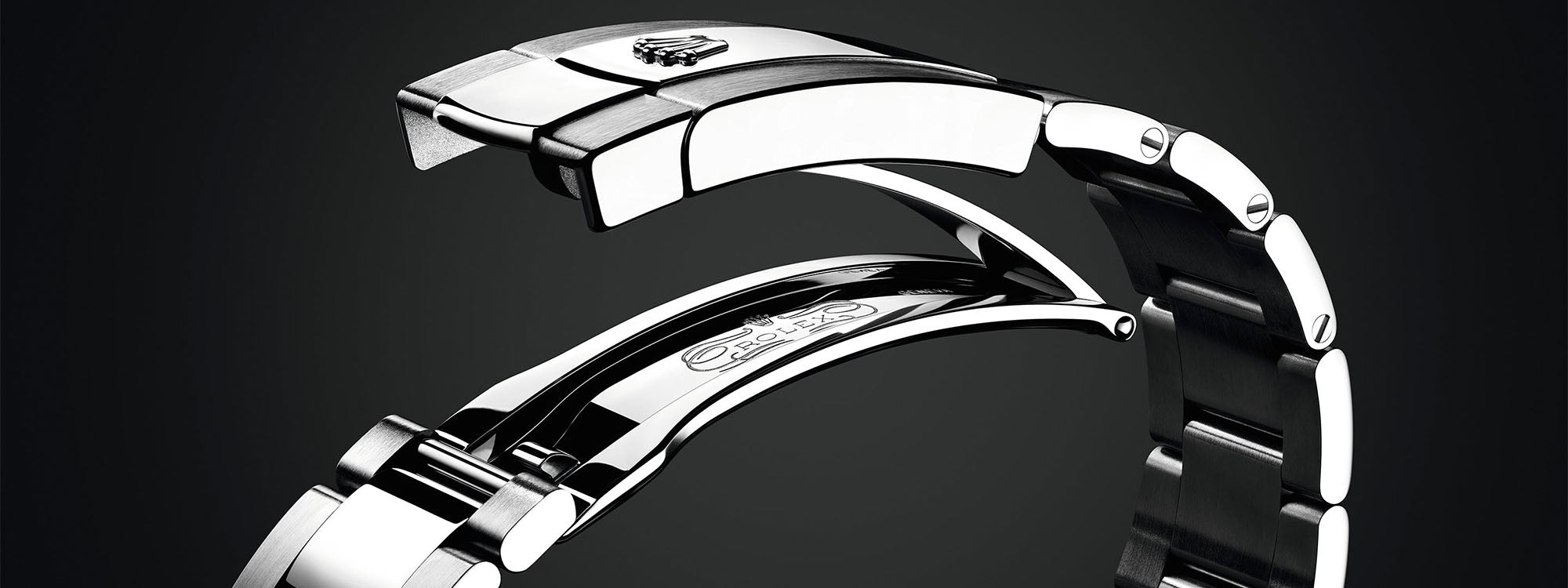As long as watches have been worn on the wrist (click here if you’re curious about how long that’s actually been), watchmakers have needed to figure out how to keep their straps, and eventually bracelets, securely fastened. Nowadays, with a plethora of strap and bracelet options available to watch wearers, there are also several styles of these closures, many of which have become brand signatures in their own right. From tang buckles to butterflies to trifolds, we cover the gamut here, listing pros and cons for each.
Pin/Tang/Ardillon Buckle

The simplest type of closure, and one used only on straps, is a pin buckle, aka a tang or ardillon buckle (“ardillon” is a French word that translates to “tongue”). If you’ve ever worn a belt, you’re familiar with the design, though perhaps not the terminology. One end of the strap — which can be either a two-piece, like most leather and rubber straps, or a one-piece, like a cloth or nylon NATO strap — has a series of perforations called adjustment holes along part of its length. The other end terminates in a simple device with a spring bar attached to a U-shaped bracket and a central piece called a mandel (the “pin” or “tongue”). The bracket slides over the other end of the strap while the mandel slips through one of the adjustment holes, and into a notch on the bracket, to fit the strap to the wearer’s wrist and secure it against coming loose. Pros: It’s easy to use and generally comfortable, as there are no large metal areas pressing against the wrist. Cons: Unfastening and refastening this type of clasp requires lots of bending of the strap and can lead to wear and tear on the holes.
Folding Clasp:

Generally found only on bracelets, the simplest folding clasp is basically an extension of the bracelet and made of the same material, such as stainless steel or titanium. Its three parts include two hinged sections that interlock on the underside of the bracelet and a top cover, often emblazoned with the watch’s brand logo or other identifying emblem, that clicks into place above them to fasten the bracelet to the forearm. Some folding clasps incorporate “safety buttons” to release the mechanism after it locks into place and an additional metal flap that folds over the cover; these are more secure and widely referred to as “safety clasps.” These “safety” buttons are also common on the more complex clasps detailed below. Pros: The folding clasp makes it easier to attach one’s watch with one hand than a pin buckle. Cons: It can be uncomfortable to wear over time if the curved metal interior doesn’t conform well to the wrist.
Single Deployant Clasp

Deployant or deployment clasps can be used on straps or bracelets and combine the three-part mechanism of the folding clasp with the spring-bar-mounted pin-and-bracket elements of the tang buckle. The simplest of these mechanisms is the “single” type that unfolds into three parts: the buckle described above and two curved, hinged, interlocking sections that separate to allow the wearer to slip the watch onto his or her wrist. When the clasp’s hinged sections are unfolded, the wearer adjusts the position of the buckle’s tongue in the holes; when snapped together, these sections secure the buckle to the wrist. Some deployant clasps include side-mounted push-buttons to easily open the hinges to remove the watch, i.e., to loosen or tighten the buckle. While it is fairly sophisticated as compared to a pin buckle, the single deployant clasp, aka deployant buckle or boucle deployant” has been around nearly as long as wristwatches themselves; Cartier patented it in 1909 and used it for the first time on the pioneering Santos watch, which it released to the public in 1911. Pros: The best of both worlds, i.e. the simple elegance of the pin buckle and the practical utility of the folding clasp, and once it’s adjusted to your wrist size, you’ll rarely need to put wear on the adjustment holes by moving the pin. Cons: Curved metal against the skin rather than soft leather or rubber (in the cases of straps), and the push-button structure can also press into the wrist.
Double Deployant/Butterfly Clasp

The most invisible type of bracelet closure is the double deployant clasp, popularly referred to as a butterfly clasp, which consists of two shorter metal hinges that unfold like wings (hence the nickname) and snap together on the surface of a larger central piece. Because the butterfly clasp is designed to hide most of its mechanisms below the underside of the bracelet or strap — usually everything except the logo-branded topside of the buckle — it imparts to the bracelet a sleeker, more seamless look than most other types. This type of deployant clasp requires spring bar attachments at both ends of the “wings.” Spring-loaded push-buttons to unlock the hinged pieces for adjusting or removing the timepiece, are also commonly found on this type of closure. Pros: The aforementioned streamlined look, plus the fact that it’s designed to open wider than a single deployant, allowing plenty of room to comfortably slip one’s wrist into the bracelet or strap. Cons: Because of its size, the butterfly clasp can be uncomfortable on smaller wrists.
Triple Deployant/Tri-Fold Clasp:

The triple deployant or “triple folding” style of clasp is the most complex, with a single folding arm inside the strap or bracelet and an overhanging plate positioned on the outer side of the bracelet that attaches to the folding part to lock it all into place for an extra layer of security. Some examples of this type of closure have an additional safety catch mechanism to prevent inadvertent unlocking of the mechanism. Rolex’s signature Oysterlock clasp fits into this category. Pros: This is the most secure system, ensuring that the watch is still attached to your wrist even if it is jarred open accidentally, and it will impart minimal wear and tear on a strap. Cons: It’s generally found on expensive watches, and can be bulky on the wrist simply because of all the layered metal parts.
Sliding Buckle:

A versatile type of clasp found often on Milanese-style steel mesh bracelets (and the occasional leather strap) is the sliding buckle, which consists of a metal part that slides along the length of the bracelet and can be locked into place when the proper sizing is found, and a clasp on the other end of the bracelet clamps down over the movable part to lock it into place. Whenever re-sizing is required, simply unlatch the top part and slide the bottom part along the bracelet to a new position. Pros: This somewhat rare type of clasp allows for a clean bracelet or strap with no adjustment holes, and should be lighter on the wrist than a deployant clasp, with no bulky folding metal parts. Cons: The sliding buckle mechanism can be difficult to pry open once it’s locked into place on the bracelet, and if it’s used on a strap, too many adjustments can wear on the leather.
Velcro Closure:

Straps with velcro closures are rare (and we’ve never seen a bracelet with one) and they certainly don’t scream luxury the way a traditional buckle of folding clasp can, but what they lack in genteel appeal they make up for in utility, particularly in watches intended for usage by the military (like the NASA-approved Speedmaster above) or in rugged outdoor situations. Pros: Like the sliding buckle, this type of closure doesn’t require any adjustment holes on the strap and can thus be fitted perfectly to any wearer’s wrist. Cons: There’s no extra layer of security if the strap comes unfastened, and you probably wouldn’t want to wear this type to a formal occasion.




























































3 Comments
I’m been looking for a butterfly clasp. One that just has an end to attach a Pin/Tang/Ardillon buckle.
Tongue end: a mount to attach a pin&tang.
Keeper end: a mount to attach would normally hold the pin&tang.
So far, all I’m finding are ones that have a metal band to go around the tongue. It always makes them look like a frankenbraclet . Depending on the width of that band, it looks more and more tacky. One I could mount my own ardillon buckle. That would allow a classic look while having the butterfly mount.
Use case: The strap would look best with a simple rose gold buckle. I could use it normally, or I could put it on a butterfly clasp. If I buy the clasp, there will be a stainless steel, one to two cm ring around the watch strap. It looks a strap slowly metamorphosis to a bracelet. If steel doesn’t look good for the watch, it clashes even more.
Part of my frustration is this should be the default clasp. If I was in a design class, I’d take a normal watch strap apart and build a clasp to hold all four pieces (tongue side, holder side, buckle, pin). The function is hidden, the form remains identical. There’s a bit of optimization on the end attachments of the clap, but that should only take an iteration or two to fix.
I’ve tried looking for such a clasp, but only find several hundred Ali Express ads. A little help, please?
Oh yes, a micro-adjustment would be grand, if not absolutely needed.
The butterfly clasps can be supremely non-adjustable. For example the newer Breitling clasps are adjustable only by removing/adding half links… this has to be done by using two jewelers screwdrivers, one on each side, rotating in different directions. This is far more troublesome than a simple pin-with-holes system.
I usually adjust my bracelets several times a year and so this is a big con for me.